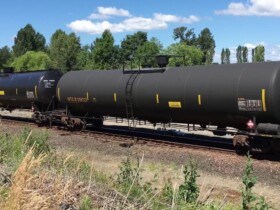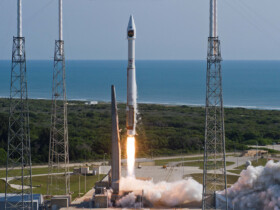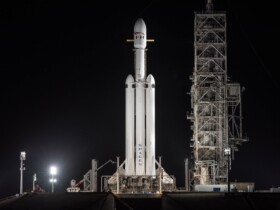Atlas SLV-3D Centaur D1AR AC-51 Launched Pioneer 13 to Venus from Cape Canaveral LC 36A in 1978.
Atlas was the first U.S. intercontinental ballistic missile, but its ICBM service was short-lived. Atlas served longer as an orbital launcher stage. It was best known for powering NASA’s original Mercury orbital missions, but it far more often launched unmanned missions with Agena or Centaur or other upper stages.

Atlas, built by San Diego’s Convair (later General Dynamics) was the “balloon tank” missile. Its stainless steel propellant tank walls were as thin as a dime in some areas and had no internal structural support. Instead, the walls were supported by internal pressure, much like an unopened carbonated beverage can.
Atlas was powered by a unique stage-and-a-half propulsion system that consisted of a jettisonable “booster package” with two powerful Rocketdyne (Y)LR89-NA5(7) engines positioned on each side of a less-powerful, but more fuel efficient and light weight, Rocketdyne (Y)LR-105-NA5(7) sustainer engine. Two small verniers, mounted on opposite sides of the vehicle above the booster package, provided roll control and trajectory tuning. All five engines ignited on the pad.
Numerous Atlas and Atlas-based variants flew during the program’s nearly 50 years duration. A total of 576 launch attempts were made with Rocketdyne-powered Atlases, not including a couple of vehicles destroyed in pre-launch propellant loading accidents. Atlas launched the first U.S. manned orbital flights, the first spacecraft to fly by another planet, the first to orbit another planet, the first to fly past the outer gas giant planets, and the first U.S.
spacecraft to impact, land on, and orbit the Moon. Centaur, which flew atop Atlas in 1962 with a first success in 1963, was the world’s first liquid hydrogen-fueled upper stage. Atlas-Agena D was the launch vehicle for numerous Gambit KH-7, a USAF reconnaissance program that was as large or larger than the U.S. Gemini program.
Atlas 2/2A/2AS were the final Rocketdyne powered Atlases, by the end produced by Lockheed Martin in Waterton Canyon, Colorado. AC-164, launched December 2, 2003, was the last heritage Atlas of 284 launched from Vandenberg AFB/Point Arguello since 1959.
On May 14, 2004, Lockheed Martin rolled rolled out AC-167, the final Atlas 2AS, shipping it to Cape Canaveral on May 16. On August 31, AC-167 closed out the heritage Atlas program with a successful launch from Space Launch Complex 36A with a National Reconnaissance Office satellite.
Six Atlas 3 launch vehicles finished the balloon tank Atlas era. They dispensed with the stage-and-a-half design, using a “Single Stage Atlas” powered by a single dual chamber RD-180 engine built in Moscow by Energomash. The final Atlas 3 flew on February 5, 2005.
Atlas 5, which used an all-new structurally stable first stage, was for all practical purposes an “Atlas” in name only.
“Baseball Card” type details of most of the flown Atlas variants are provided in the following links, listed in approximate chronological order.
Atlas ICBMs (Atlas A-F)
Atlas in its original ICBM form. Atlas D was the first operational version, fitted with Mk 2 and Mk 3 reentry vehicles (RVs). Atlas E and F with Mk 4 RVs and inertial guidance were the ultimate ICBM variants. Atlas E was based in above ground horizontal “coffin” shelters with retractable roofs. Altas F was based in vertical silos fitted with an elevator that lifted Atlas to the surface for propellant loading. Note that the intertank was moved for Atlas C and later, enlarging the LOX tank and shrinking the RP-1 tank compared to the original design. Atlas D served as the starting point for subsequent space launch vehicle variants.
Also read: Atlas III – Space Launch Report
Atlas 10B SCORE
SCORE (Signal Communications by Orbiting Relay Equipment) was famously launched by Atlas 10B from Cape Canaveral LC 11 on December 18, 1958. The entire Atlas sustainer stage boosted itself to a 159 x 1,187 km x 32.29 deg orbit. The usual 1.5-ish tonne RV was replaced by a lightweight nose fairing. The sustainer and 68 kg of additional SCORE hardware weighed 3,969 kg. It was the first orbital Atlas, and only the fifth U.S. orbital success. It was also the very first U.S. Air Force orbital success.
10B got to orbit in a hurry, and endured some high-g forces before SECO to get there. It played the very first human voice (from a recording) ever sent from an American satellite to the ground. SCORE demonstrated a basic store and forward capability. Recordings could be uplinked to a tape recorder, and then played back down. SCORE’s most famous transmission was a pre-recorded holiday message to the world from U.S. President Eisenhower.
Atlas-Able
Atlas-Able was the “least successful” U.S. launch vehicle. NASA, formed in October 1958, needed interim launch vehicles immediately. Atlas-Able was created by adding the already developed Vanguard (“Able”) second stage. Schedule slips thwarted plans for it to launch Pioneer to Venus in June of 1959. The Agency settled on a lunar orbit plan instead. The intricate STL Pioneer P satellites that resulted were advanced for their time, with built-in thrusters to insert themselves into lunar orbit.
The first Atlas Able (Atlas 9C) was destroyed in an FRF attempt at LC 12 on September 24, 1959. Helium improperly injected into the sustainer fuel pump line due to a configuration error caused cavitation, overspeed, shutdown after 2 seconds, and a sustainer propellant duct failure that fed a fire in the Atlas engine section. The tanks soon failed and the vehicle exploded. No satellite was on-board.
Atlas 20D Able 4B launched from LC 14 two months later, but the payload fairing failed 45 seconds after liftoff. The design neglected to provide a means of equalizing air pressure inside the fairing. Atlas 80D Able 5A came nearest success on September 25, 1960, when Atlas burned out and Able ignited its AJ10-103 engine. Unfortunately Able failed after 67 seconds due to an oxidizer system problem in the pressure fed stage. Atlas 91D Able 5B failed on December 15, 1960 when the Able stage ignited early, at T+70 seconds, while the Atlas booster burn was still underway.
Atlas LV-3B Mercury
Atlas LV-3B Mercury put John Glenn, Scott Carpenter, Walter Schirra, and Gordon Cooper into orbit, not to mention chimpanzee Enos. LV-3B was an Atlas D modified with an Abort Sensing & Instrumentation (ASIS) failure detection system and, after the MA-1 failure, with a beefed up tank section near the spacecraft adapter. Other changes included simultaneous SECO/VECO, lightweight telemetry, and redundant autopilot.
Three of the first four launches, including the precursor Big Joe flight, suffered some type of failure. Atlas itself was still only succeeding during a little more than half of its flights. Still Glenn and the others climbed aboard without hesitation. Crazy? Maybe a little. Brave? Absolutely. National heroes? They gave astronauts ticker tape parades and medals back then.
Atlas LV-3A Agena A
Atlas LV-3A Agena A only flew four times during 1960-61. It was a stop-gap measure until the larger Agena B stage came on line. Agena A, also flying on Thor at the time, was troubled at this stage. Lockheed was still climbing the spaceflight learning curve. Two launches with MIDAS payloads (precursor IR missile sensing satellites) took place from the Cape. Atlas and Agena collided at staging on the first attempt. The second launch made it to orbit, but Agena soon tumbled out of control. Two subsequent launches carried SAMOS payloads from Vandenberg AFB PA 1-1 (today’s mothballed SLC 3W). Agena failed on the first try. The second made it to near polar orbit. SAMOS took photographs, then scanned the photos and transmitted them by radio. Image quality turned out to be insufficient for reconnaissance.
Atlas LV-3A Agena B
When it began flying in mid-1961, Atlas LV-3A Agena B was the heaviest, most-capable rocket the United States had launched up to that time. The stretched Agena had, for the first time, a restartable engine. LV-3A Agena B worked for both the U.S. Air Force and NASA from the outset, launching MIDAS and SAMOS from Vandenberg and Ranger and Mariner from Cape Canaveral for a 28 launch total. SAMOS turned into a frustrating program failure. MIDAS did better, though with many early setbacks, setting the stage for later missile warning satellites. Both used Agena as a spacecraft bus. Ranger failed stubbornly for two years until No. 7 finally photographed the Moon before impact in mid-1964. Mariner 2 was a major early success. Agena B restarted successfully to send the little JPL satellite toward mankind’s first successful flyby of another planet (Venus) in 1962.
Atlas LV-3C Centaur A-D
LV-3C/Centaur was the original “Atlas Centaur” with the world’s first liquid hydrogen fueled orbital stage. Twelve were launched between 1962 and 1967, during a tortuous development program. The first launch failed on May 8, 1962 when Centaur’s insulation panels failed during the first minute of flight. Four more failures would follow (a total of three orbit fails and two RL10 restart fails). One of them, AC-5, ended in the biggest on-pad explosion yet seen in Florida. The first real payload, Surveyor 1, wasn’t launched until May 30, 1966 by AC-10 (the 8th flight). Surveyors 2-4 followed before the more capable SLV 3C/Centaur D vehicle took over.
The program was saved (after a Congressional investigation) by wresting it from MSFC and placing it in the hands of Lewis Center’s Abe Silverstein. Program development costs increased by nearly a factor of six from original plans. In hindsight, with Centaur still serving the nation, it was worth every penny.
There were four insulation panels that separated using “flexible, linear, shaped charges” along their “forward, aft, and longitudinal seams”. Hinge arms at the bottom of the panels caused them to rotate away from the vehicle. A helium purge between the tank wall and the insulation panel used ground source helium that ended at liftoff, requiring careful venting during the flight. Jettisoning the insulation shed 552 kg of dry mass from the stage on the way up, adding hundreds of kg of payload capability.
Atlas NIKE Target
In 1962, Atlas D began its first non-ICBM suborbital mission – launching targets for Nike Zeus ABM test intercepts. Nike launches from Kwajalein attempted to “intercept” the RVs upon reentry (a few hundred meters distance counted because operational Nike would use nuclear warheads for ABM intercepts). The program effort was remarkably robust compared to today’s infrequent test attempts for the current ABM system.
The RVs looked vaguely similar to Avco RVs that ended up on Minuteman missiles. There were 16 launches, including one by an Atlas E, during the initial “Nike Target Missile (or Measurements) Program”. Some were only launched to be tracked by the Nike radar systems. Four were Atlas failures. Some saw the Nike aim for the disintegrating Atlas tank rather than the RV. One intercepted a decoy rather than the RV. Four were outright successful “intercepts” of the RV itself. A variety of RVs were used, and decoys were part of the mix.
Nike Zeus was cancelled in favor of Nike-X, and 20 more Atlas launches were performed during 1964-66 as part of the “Nike-X Reentry Measurements Program”. These featured a new cylindrical section named “HIRS” that housed a pair of retro rockets to push Atlas further away from the RV after separation. HIRS was also used by ABRES. Many were launched only to be tracked. Others may have been intercept attempts, but information is vague. Four were Atlas failures. A variety of RV types appear to have flown. Two examples are shown.
Atlas ABRES
ABRES (Advanced Ballistic Reentry Systems) was a long running program that encompassed about 70 Atlas launches. These were used to develop new ICBM reentry vehicles and decoys, and to continue ABM testing, including tracking system testing. Launches began from Cape Canaveral, but soon settled on the Vandenberg AFB 576 A and B complexes, which included six launch pads. During the mid 1960s these were among the busiest launch pads in the U.S.. The program was substantial. Most launches aimed toward Kwajalein, but a few went toward Johnston or Wake Islands.
The Narwhal-like SBGRV vehicles were distinctive, topped by long, 2,000 pound RVs built by Douglas that used flaps and gas jets to maneuver. Ford-Philco developed the Trident post-boost bus, which used dual-thrust solid motors, to launch numerous RMP-B (Reentry Measurements Program) missions and which apparently tested MIRV techniques. HIRS was used on some missions. Maneuverable RVs were tested. Some of this stuff is still cloaked in mystery, since it developed pointy-nosed, stealthy RVs for Minuteman and Trident and other missiles.
Atlas LV-3A Agena D
Atlas LV-3A/Agena D flew 15 times during 1963 to 1965, before being supplanted by the standardized Atlas SLV-3. Agena D was a first step in that standardization, since it was designed to fly on Thor, Atlas, and Titan. Atlas Agena D was developed primarily to orbit NRO’s Gambit-1 from Vandenberg AFB. Ten of the 15 LV-3A/Agena D flights did exactly that. Gambit-1 was the first seriously impressive U.S. imaging spysat. It likely cost more than NASA’s Gemini program.
LV-3A/Agena D also launched three pairs Vela satellites from Cape Canaveral LC 13 into deep orbits beyond the GEO belt, where they monitored for signs of nuclear explosions following the signing of the nuclear limited test ban treaty.
Public awareness of LV-3A/Agena D was limited to the Mariner 3 and Mariner 4 launches in November, 1964. Both JPL spacecraft were processed simultaneously. Mariner 3 flew from LC 13 and Mariner 4 from LC 12. Both made it to solar orbit, but Mariner 3 died in its never-ejected shroud. Mariner 4 performed the first successful flyby of Mars, returning the first close photographs of its surface.
Atlas SLV-3 Agena D
SLV-3 Agena D flew 47 times during 1964-1967. A lone SLV-3 Agena B flew for NASA in 1966.
Gambit-1 accounted for 28 launches including 2 failures. GATV flew 6 times, suffering two frustrating launch failures but also scoring the first orbital docking missions with Gemini. Five highly successful Lunar Orbiters were launched for NASA without a hitch. Midas/RTS-1 flew three times, advancing missile detection technology despite one ending up in an unplanned elliptical orbit. Three ATS launches were performed for NASA, with one falling short of a full GTO due to an Agena failure. Mariner 5 was successfully launched toward Venus on the final Mariner/Agena flight.
Snapshot is an attention grabber. Launched in March 1964 from Vandenberg AFB PALC 2-4 (today’s SLC 4E used by Falcon 9), Snapshot remains the only nuclear reactor ever orbited by the United States. Its SNAP-10A reactor, loaded with 1.35 kg of U-235 fuel rods, went critical as planned soon after reaching its 1,300 km x 90 deg orbit. It operated 45 days before a power system failure caused it to automatically shut down. Years later, the inert satellite (which includes the attached Agena) began shedding debris. No one knows if radioactive material is involved, but it is all still up there.
Atlas D FIRE
After Project Mercury, and straddling the beginning of Project Gemini, NASA launched two Atlas D rockets with a mini-Apollo capsule on top within a shroud to test it at 11,300 m/s reentry velocity. This was Project FIRE (Flight Investigation of Reentry Environment). Atlas launched the FIRE payload, which included an Antares IIA solid motor, on a high apogee suborbital trajectory. After coasting past apogee, the spin-stabilized Antares IIA motor fired to accelerate the 87 kg “Reentry Package” toward the atmosphere. The successful launches took place from Cape Canaveral LC 12. The capsules, not designed to be recovered, impacted near the Ascension Islands some 8,250 km downrange after transmitting a wealth of data.
Atlas D/F OV-1
“Orbiting Vehicle” satellites were conceived by the Air Force as a low-cost way to piggyback small satellites onto suborbital ABRES Atlas flights. They consisted of a Propulsion Module built around an Altair 2 or 3 solid motor with cold-gas 3-axis control added, topped by a torpedo-like satellite. The vehicle would be ejected about five minutes after liftoff and coast to apogee before firing its motor to acheive orbital velocity.
The first two OV-1 attempts in 1965 rode as initially conceived in side-mounted pods. The first Atlas almost succeeded, but suffered an early sustainer shutdown and the OV-1 1 payload failed to separate. The Avco MTV-1 reentry vehicle apparently failed to meet its objectives due to the Atlas sustainer issue. The second Atlas, topped by a Mk 3 RV, failed outright.
The program then switched to dedicated Atlas D vehicles with pairs of nose-mounted OV-1 payloads housed in odd hammerhead shark-like fairings. Five launch successes followed, with eight OV-1 successes and two OV-1 payloads that failed to separate or failed to reach orbit after separating. One OV-1 was a dummysat. The first three were flown down the Western Test Range, producing retrograde orbits with 144 deg inclinations. The last two Atlas D OV-1 missions flew to near-polar orbits, with the final launch in 1967 carrying two nose-mounted and one side-mounted OV-1 payloads.
OV-1 then moved to Atlas F, where the 84 inch diameter Trident program interstage was used along with a payload fairing to house up to three vehicles. More powerful Altair 3 motors were employed. Seventeen total payloads were orbited, including ten that had OV-1 designations. All went to near-polar orbits. It must have been interesting to track these missions with their multiple motor firings all in close order.
Also read: Ariane 6 – Space Launch Report
Atlas SLV-3B Agena D
When it flew from Cape Kennedy’s LC 12 in 1966, NASA’s Orbiting Astronomical Observatory (OAO 1) was called “the largest, heaviest and most electronically complex unmanned spacecraft ever developed by the United States”. The big payload required a 3.048 meter diameter shroud that covered both OAO 1 and the Agena stage that inserted it into orbit. Thus was born SLV-3B Agena D, an Atlas configuration that only flew once.
SLV-3B basically married an LV-3C Atlas Centaur first stage with an Agena second stage. General Dynamics/Convair developed the three-piece shroud, which had a fixed part and two bisector jettisonable parts. A special interstage adapter was also developed to hold Agena inside the shroud. The shroud separated after SECO but before VECO. Agena fired first to reach a roughly 140 x 800 km x 35 deg transfer orbit. It restarted at about T +50 minutes to put OAO 1 into an 800 km x 35 deg final orbit. (OAO-1 and Agena are both still up there as of 2015 in those relatively high orbits.)
SLV-3B Agena D worked perfectly, but OAO 1 suffered a massive electrical system failure after only 20 orbits and was lost. For some reason the launch vehicle, which cost a good bit of money and time to develop, never flew again.
Atlas SLV-3 (ATDA/Prime)
During 1966 and 1967, four SLV-3 series Atlas vehicles launched with no upper stages. The first carried the Augmented Target Docking Adapter (ATDA) into a 300 km x 28.9 deg orbit for the Gemini 9A mission, a couple of weeks after the original Agena-launched target was lost in an Atlas failure. ATDA, a back-up target, did not have its own propulsion system, only an attitude control system, so Atlas did all the work and the sustainer stage also reached orbit. The ATDA shroud failed to separate, creating the famous “Angry Alligator” that still provided useful service as a rendezvous target for the Gemini 9A crew.
The U.S. Air Force performed three SLV-3 Atlas launches from Vandenberg AFB SLC 3E with Martin X-23A (SV-5D) PRIME (Precision Reentry Including Maneuvering reEntry) lifting body re-entry vehicles. These were suborbital flights down the western missile range that demonstrated cross-range maneuvering by the 405 kg SV-5D vehicles. All three launches and reentries were successful, but the SV-5D was only able to be recovered on the third and final flight. A fourth SV-5D and SLV-3 were nearly ready to fly when the program was stopped due to the earlier successes. You can see the recovered and unflown SV-5D vehicles at the USAF Dayton museum. The unused Atlas SLV-3 was re-assigned to lift a Burner 2 upper stage and payload in 1968.
Atlas SLV-3C Centaur-D
From 1967 through 1972, Atlas SLV-3C Centaur D launched Surveyors, Mariners, and Pioneers, including the first made made objects to orbit another planet (Mariner 9) and to leave the solar system (Pioneer 10).
Atlas SLV-3A Agena D
The workhorse Atlas-Agena (mostly SLV-3/Agena D) flew 25 times in 1966, launching Air Force and NASA payloads from five launch pads at two launch ranges. The numbers fell to 9 launches from three pads in 1967, as the Air Force dialed down KH-7. Suddenly, as 1968 began, only Cape Canaveral’s LC 13 remained active. On it was stacked the last standard NASA Atlas-Agena D (there would be one final one-off Atlas F/Agena D for Seasat in 1978).
It was the first stretched SLV-3A Atlas, sometimes called “Long Tank Atlas”, more often called “Improved Atlas for Agena”. It launched OGO-5, then went “black” launching Canyon and Rhyolite/Aquacade COMINT/ELINT satellites for DoD until 1978 (a total of 12 launch attempts including OGO-5). Only a few photos of the secret SLV-3A/Agena D vehicles have appeared (only two or three of the twelve). The Rhyolite/Aquacade Agenas were topped by crazy-long fairings. The shorter Canyon fairings were shiny gold. Who knows, maybe it was gold!
Atlas Burner 2
Atlas was topped by Boeing’s Burner 2 stage on two occasions. The first used the unassigned SLV-3 booster (7004) from the PRIME program to launch a cluster of 11 or so small Space Test Program satellites from Vandenberg AFB SLC 3E on August 16, 1968. Burner 2 had been developed to fly on retired Thor boosters using a small conical payload fairing.
For this first Atlas flight, however, a very long cylindrical section was added to the shroud so that it was half as long as the Atlas itself! Something happened, reported variously as “shroud collapsed” or “shroud failed to separate” or “Burner 2 failed to start”. Likely all three statements are true. At any rate, the planned near-polar orbit was not achieved.
The failure may have dashed plans for more frequent Atlas Burner 2 missions, because Boeing’s stage, which was essentially a Star 37B solid motor held in a frame that included its own guidance system with three-axis attitude control and velocity trim via. hydrogen peroxide thrusters and cold gas RCS, only flew one more time on Atlas. The final flight used retired Atlas 102F to orbit Radsat and Radcat 2 from the old 576 A1 pad on October 2, 1972. Note that this successful flight used a shorter payload fairing.
Atlas SLV-3D Centaur D-1A
Atlas SLV-3D Centaur D-1A(R) was NASA’s main-stay medium lifter during the 1970s and early 1980s. Though dimensionally similar to SLV-3C Centaur D, it had improved booster thrust (more than 431 Klbf), better sustainer specific impulse, updated avionics that allowed Centaur to control the entire launch vehicle, a bigger fairing option, tweaked Centaur thrust (up to 33 Klbf for AC-54 and later) and other refinements made during the vehicle’s production run that steadily improved performance. GTO capability, for example increased from 1,860 kg (AC-30) to about 2,000 kg (AC-61).
SLV-3D launched Pioneers 11-13, Mariner 10, and three HEAO satellites for NASA. It orbited fleets of GEO comsats for the U.S. Navy, for Intelsat, and for Comstar. There were three launch failures in this rocket’s 32 flights. FLTSATCOM 5, one of the failure, reached its planned orbit but its UHF antennas were damaged by the delamination of the inner lining of the shroud. The satellite was nursed to near-GEO and its solar arrays were deployed, but its antennas would not deploy.
Atlas E/F GPS
Numerous retired Atlas E and F missiles were repurposed and flown to orbit. Most were serially refurbished at Vandenberg AFB in the Vandenberg Atlas Modification Program (VAMP). The majority were topped by solid motor stages. From 1974, all flew from Vandenberg AFB SLC 3E or 3W.
Thirteen Atlas E/F flights carried early developmental GPS satellites. An 84 inch diameter fairing, derived from the Atlas/Trident shroud, was used to house the top few inches of the tapered Atlas LOX tank, one or two solid motors, and the payload. Atlas flew suborbital, then the spin-stabilized solid motors fired to boost the payload into an elliptical transfer orbit. An apogee kick motor assigned to the payload circularized the orbit later.
The Payload Transfer System (PTS) used a single Star 37E to orbit Navigation Test Satellite 1 in 1974. It served as a prototype for Space Guidance System 1, which used two Star 37E motors fired sequentially to launch NTS-2 in 1977, and GPS 1-7 subsequently. Fairchild was the PTS and SGS-1 contractor. All launches succeeded until the final SGS-1 launch with GPS 7 in 1981. An improperly refurbished booster engine failed at T+6 seconds and Atlas crashed only 500 feet from SLC 3E.
McDonnell Douglas created SGS-2, which used two stacked Star 48B motors to launch GPS 8-11 during 1983-85.
The re-purposed Atlas missiles provided a cost-effective, and generally successful, launch service for the first generation GPS satellites.
Atlas E/F OIS/Star
Retired Atlas E/F ICBMs flew once each with Star 17A and Star 20 solid motor upper stages, and twice with Star 27 upper stages that were integrated with 3-axis control by Fairchild as “Orbital Insertion Stage(s)” (OIS).
Atlas 71F carried the Star 17A on the STP P72-2 mission on April 13, 1975 from SLC 3W. It used a 65 inch diameter fairing, within which rode a Rockwell-built RM-20 satellite. In those days, RP-1 and LOX were ducted into the flame trench during the countdown. This time, the propellants pooled and exploded when the Atlas engines ignited, damaging the propulsion system. Still, Atlas lifted off and headed downrange. Eventually, the damaged engines shut down and at T+303 seconds Range Safety pushed the button.
Atlas 27F/OIS boosted the 850 kg Solwind satellite into a nearly 600 km x 97.8 deg orbit from SLC 3W on February 24, 1979. Atlas 41E /OIS lofted 635 kg Geosat into a 775 km x 108 deg orbit from the same pad on March 13, 1985. Geosat was classified for NRL, then it performed a declassified mission, then, gradually, more and more of the classified mapping data was released.
Atlas 28E with a Star 20 (Altair 3A) motor orbited three “Stacksats” and a “Prototype Deployment Device” on the STP P87-2 mission from SLC 3W on April 11, 1990. A 745 x 627 km x 89.8 deg orbit was achieved. The Stacksats and the Star 20 were originally designed for Scout launches.
Atlas E/F MSD
Atlas E/F, topped by the Multiple Satellite Dispenser (MSD), carried Parcae (Naval Ocean Surveillance System) triplets into 1,100 km x 63 deg orbits beginning in 1976. Parcae were SIGINT/ELINT satellites for the U.S. Navy that were used to track the then-expanding Soviet navy. They flew in “formation” to allow use of the radio signal time difference of arrival method.
MSD was built around an FW-4D solid motor, previously used as a Scout fourth stage and a Delta third stage. It was fitted with an MMH monopropellant trim system. The FW-4D was spin-stabilized during its apogee kick burn.
The first three launches using Atlas F stages were successful. The final launch, using Atlas 68E, failed on December 9, 1980 when one of the booster engines shut down just before its planned cutoff, putting Atlas into a spin. The sustainer engine fired, but in the wrong direction and it all ended in a high altitude explosion several minutes after liftoff. The Soviet Navy gained a reprieve, briefly.
Atlas 23F Agena D
One-of-a-kind Atlas F Agena D boosted Seasat into near-polar orbit from VAFB SLC 3W on June 27, 1978. For this NASA/JPL mission, which required a wider payload fairing, General Dynamics modified Atlas 23F (originally manufactured in 1961 for ICBM duty), cutting off its tapered LOX tank section and replacing it with a cylindrical section. GD also provided a modified interstage from its Atlas-Centaur program. Lockheed provided the payload fairing, which was a modified leftover ground test article from its Titan 3B/Ascent Agena program. Agena D fired twice to reach a 780 x 790 km x 108.022 deg orbit, then served as a bus for the innovative synthetic aperture radar imaging satellite. Seasat mapped sea states before suffering an electrical failure 106 days into its mission.
This scrounged-up oddball rocket, which worked to perfection, was the final Atlas-Agena.
Atlas E/F ISS
Here’s Atlas E/F with a Star 37S upper stage. The Star motor was integrated with the satellite so that it could provide coast and roll control. Atlas itself flew suborbital. Star 37S ignited after a five minute coast to apogee to complete the orbital insertion. These put NOAA and DMSP-5D2 weather satellites into sun synchronous orbit from Vandenberg AFB from 1978 until 1995. The last one was the final refurbished ex-Atlas ICBM to fly.
Atlas H
Atlas H (which started flying one year before Atlas G/Centaur) was developed to orbit more Parcae (White Cloud or NOSS) triplets during the 1980s. It used an SLV-3D first stage, with an MSD solid motor upper stage replacing Centaur. An Atlas E/F “GERTS” autopilot and radio-inertial guidance system was added to the first stage, as was a vernier solo phase capability and a 10 foot to 7 foot tapered adapter. The MA-5 propulsion system continued to see improved thrust and specific impulse. Atlas H flew five times from Vandenberg AFB SLC 3E during the 1983-87 period. The rocket may have been created as an interim solution while waiting for West Coast STS.
Atlas G Centaur D-1AR (“Atlas 1”)
Atlas G Centaur and its similar cousin Atlas 1 flew 18 times between 1984 and 1997. Five of those flights failed and another was damaged during launch processing, possibly symptomatic of the stop-start nature of the program during that era. Subsequent Atlas success sprung from this difficult era, when Atlas production was shutting down in favor of Shuttle.
Atlas G featured an 81 inch Atlas stretch compared to SLV-3D. It’s MA-5 propulsion system was up-thrusted once more to produce nearly 440,000 pounds of thrust at liftoff (with an ISP up-tick to boot). Centaur’s boost pumps were eliminated and its thrusters and RL-10 engines were improved.
The rocket, still under NASA Lewis Center purview, was developed primarily to boost 2,313 kg FLTSATCOM 5A to GTO. Only the Cape’s LC 39B was modified to handle the taller rocket while LC 39A was assigned to the Shuttle-Centaur program.
AC-62, the first to fly in 1984, failed when the Centaur LOX tank was punctured by the stage separation system. Subsequent launches were successful until AC-67 was astonishingly knocked down by lightning in 1987. The AC-68 Centaur stage was “deflated” during launch processing, requiring construction of a new stage for “AC-68R”, which finally orbited FLTSATCOM 5A 8 on September 25, 1989, ending NASA oversight.
By then, after Challenger, Atlas Centaur production had resumed. “Atlas 1” was programmed as a commercial launch service. It was essentially an Atlas G Centaur D-1AR with an improved guidance system and a 165 inch diameter metal payload fairing option. AC-69 through AC-79 flew during the 1990-97 period, orbiting commercial, NASA, and USN payloads. AC-70 and 71 suffered RL-10 failures and AC-74 suffered a rare MA-5 sustainer failure. The Atlas 2 series with all of its improvements flew concurrently with Atlas 1 for seven years. AC-79 was the last Atlas with vernier engines and the last Centaur with jettisonable insulation panels.
Atlas 2/2A(S)
General Dynamics won the USAF MLV-2 competition in 1988. The company developed the Atlas 2 series for MLV-2. After years of underinvestment, Atlas and Centaur were finally able to be upgraded. Atlas was stretched 9 feet and Centaur by 3 feet. Centaur gained fixed foam insulation. Guidance system improvements were made. Atlas gained an upgraded MA-5A propulsion system that produced nearly 480 Klb liftoff thrust. The old Atlas verniers were removed, replaced by a new hydrazine roll control system on the interstage. Atlas 2 still used two RL10A-3-3A engines, but Atlas 2A used higher thrust, higher ISP RL10A-4 engines with extendible nozzles. Atlas 2AS added four Thiokol Castor 4A solid rocket boosters, two ground-lit and two air-lit.
Cape Canaveral’s dormant LC 36A was returned to launch service, alongside still-active 36B, and Vandenberg AFB SLC 3E was completely rebuilt for the first West Coast Atlas Centaurs (Atlas 2AS beginning in 1999).
Ten Atlas 2, 23 Atlas 2A, and 30 Atlas 2AS launches took place with no failures during 1991-2004.
Meanwhile, the Cold War ended. Martin Marietta merged GD in 1993, then Lockheed Martin took over in 1995. GD’s long-running Atlas production line was shut down and moved to Waterton Canyon, Colorado sometime during 1995-96 or so. Kearny Mesa rolled out its last Atlas – AC-126 – on September 27, 1995 and was subsequently razed, the land sold off. For many that seemed to be the end of the real Atlas program, but Atlas would flourish yet under Lockheed Martin’s management. AC-122, which flew two months after AC-126 during April 1996, was the first Atlas assembled at Waterton.
Atlas 3 A/B
After Martin Marietta merged General Dynamics in 1993, the company took a fresh look at Atlas. Atlas 2AR, announced after Lockheed merged Martin Marietta in 1995, was the resulting plan. It would greatly simplify the launch vehicle, replacing the stage-and-a-half concept with a “Single-Stage Atlas” with a powerful new propulsion system that would allow removal of one of the two Centaur engines and lift more than 4 metric tons to GTO.
Candidate first stage engines included RD-180, two NK-33, and a pair of proposed “RS-X” Rocketdyne engines. Rocketdyne, focused on RS-68 development, dropped out of the competition in September, 1995. RD-180 won the job in Janaury 1996 and it became apparent that Lockheed Martin expected the new rocket to serve as a “risk mitigator” for its proposed EELV design, which was one of four competing designs selected in 1995 for the final round.
Sometime after 1996, “Atlas 2AR” was renamed “Atlas 3A” and follow-on “Atlas 2ARC” became “Atlas 3B”. The Atlas stage was the same for both. Atlas 3A used a Centaur with the same dimensions as the Atlas 2/2A Centaur, while Atlas 3B introduced the stretched “Common Centaur” that still
essentially flies today atop Atlas 5. Early plans for an “Atlas 2ARS” with two Castor strap-on motors were dropped.
In early 1998, an integrated stage hot firing of an RD-180 attached to an Atlas 3 test thrust structure took place at Marshall Space Flight Center. This was the highest thrust engine tested at MSFC since F-1 during the 1960s.
Launch Complex 36B was modified to support all Atlas 3A/B launches. In the end, there would only be six, all successful. Atlas 3A was ready to fly in 1999, but payload issues pushed its inaugural “AC-201” launch back to May 24, 2000, when it orbited Eutelsat W4. AC-204, the first Atlas 3B (this one with a Dual Engine Centaur) flew next, with Echostar 7 on February 21, 2002. Atlas 5 would fly before any more Atlas 3 flights took place. As a result, Atlas 3 was soon phased out, with a final launch in 2005 by AC-206 with two Intruder satellites. AC-206 was the final launch from historic LC 36. The entire two-pad complex was leveled to bare earth not long after.
















Got a Questions?
Find us on Socials or Contact us and we’ll get back to you as soon as possible.